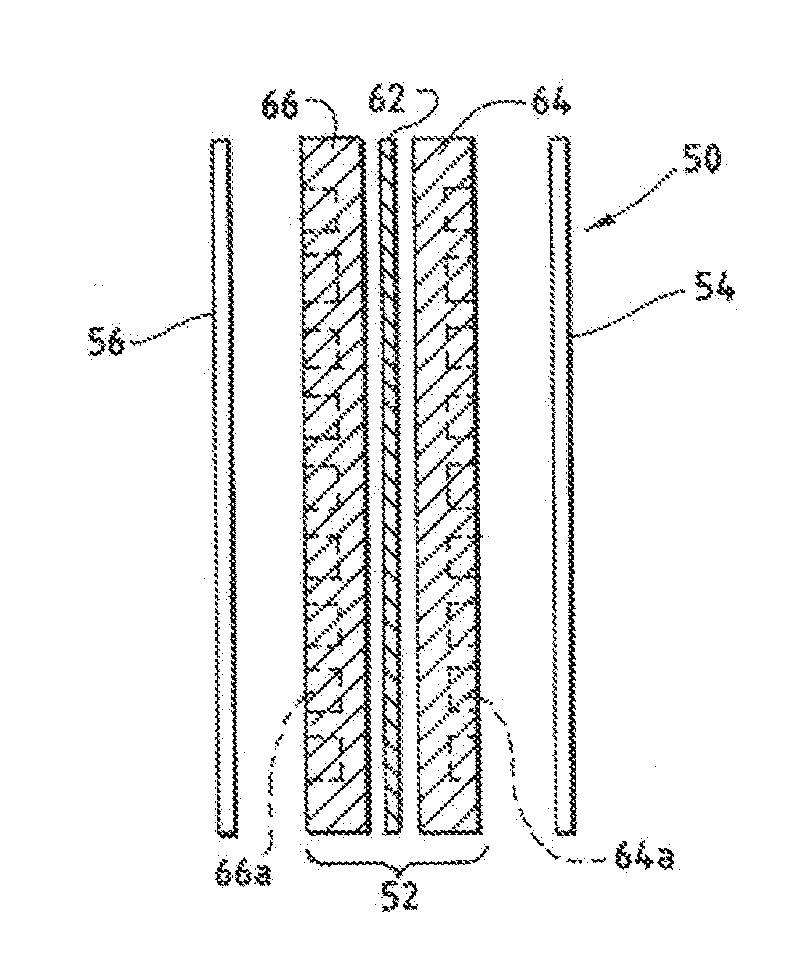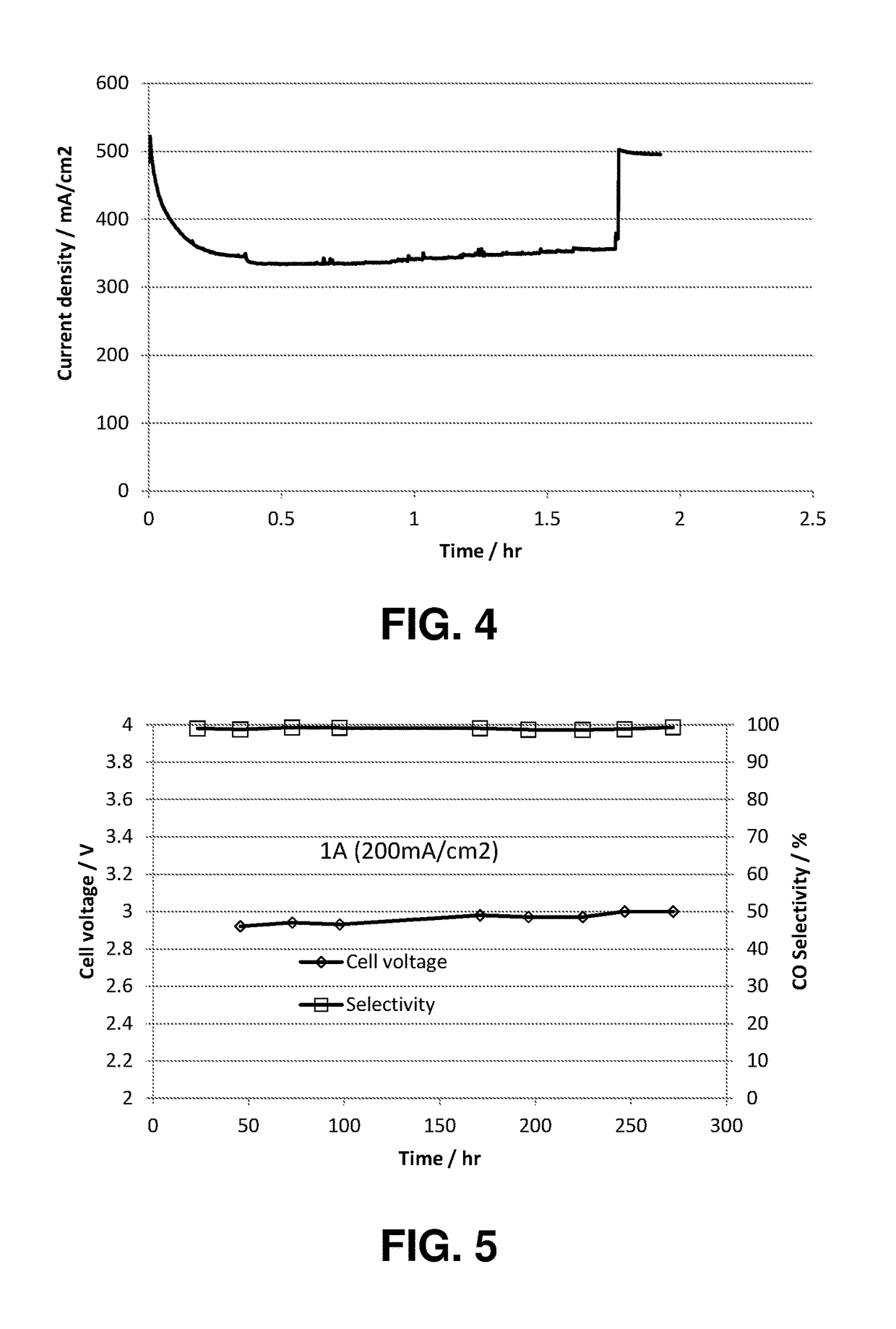Ion-Conducting Membranes
a technology of conducting membranes and ion channels, applied in the field of electrochemistry, can solve the problems of inability to achieve faradaic efficiency in constant voltage experiments greater than 32%, and small practical application potential,
- Summary
- Abstract
- Description
- Claims
- Application Information
AI Technical Summary
Benefits of technology
Problems solved by technology
Method used
Image
Examples
specific example 1
[0081]Specific Example 1 illustrates a procedure to create an electrolyzer with a Helper Membrane. The embodiment of Specific Example 1 demonstrates improved performance over earlier electrochemical cells used for CO2 conversion.
[0082]Measurements were conducted in an electrolysis cell with an anode, cathode, and anion-conducting polymer electrolyte membrane held in Fuel Cell Technologies 5 cm2 fuel cell hardware assembly with serpentine flow fields.
[0083]The cathode in Specific Example 1 was prepared as follows. Silver ink was made by mixing 30 mg of silver nanoparticles (20-40 nm, 45509, Alfa Aesar, Ward Hill, Mass.) with 0.1 ml deionized water (18.2 Mohm, EMD Millipore, Billerica, Mass.) and 0.2 ml isopropanol (3032-16, Macron Fine Chemicals, Avantor Performance Materials, Center Valley, Pa.). The mixture was then sonicated for 1 minute. The silver ink was then hand-painted onto a gas diffusion layer (Sigracet 35 BC GDL, Ion Power Inc., New Castle, Del.) covering an area of 2.5 c...
specific example 2
[0119]The object of this example was to determine whether changes in the membrane doping could activate a membrane for CO2 conversion. AMI-7001 and CMI-7000 were chosen as test examples since they have the same polystyrene backbone as in PSMMIM and PSDMIM, but different amine groups, so they might be able to be activated.
[0120]The AMI-7001 was pretreated by soaking the membrane in a 1 M NaCl solution for one hour, followed by soaking in water for about 3 hours.
[0121]The selectivity rose to 70%. The current density was still low (3.5 mA / cm2). So this membrane is still not a Helper Membrane but its performance is much better.
[0122]The CMI-7000 was pretreated using the same procedure. Again, the selectivity rose to 72%. The current density was still low (15 mA / cm2).
[0123]Still, it is likely that the current could be raised if thinner membranes were made with the same bulk composition as AMI-7001 and CMI-7000, and then the membranes were doped with NaCl. Such a membrane could be a Helpe...
specific example 3
[0124]The objective of Specific Example 3 is to provide another example of a Helper Membrane.
[0125]Preparation of PSDMIM: Poly(4-vinylbenzyl chloride-co-styrene) was prepared as in Specific Example 2. 1,2-dimethylimiazole (Sigma-Aldrich) (2.8455 g, 0.0296 mol) is added to the solution of the poly(4-VBC-co-St) (5.0907 g) in anhydrous N,N-Dimethylformamide (DMF) (Sigma-Aldrich) (30 mL). The mixture was stirred at room temperature for 0.5-1 hour, and then heated at 110-120° C. for 66.92 hours. PSDMIM was obtained as a yellowish solid after purification by precipitation into diethyl ether.
[0126]A PSDMIM membrane was formed as in Specific Example 2. Then the membrane was tested as in Specific Example 1. The results are given in Table 2 below. PSDMIM refers to a co-polymer of styrene and 1-(p-vinylbenzyl)-2,3-dimethyl-imidazolium:
[0127]where X− is an anion and m>0 and n>0.
PUM
| Property | Measurement | Unit |
|---|---|---|
| thickness | aaaaa | aaaaa |
| temperature | aaaaa | aaaaa |
| current density | aaaaa | aaaaa |
Abstract
Description
Claims
Application Information
 Login to View More
Login to View More - R&D
- Intellectual Property
- Life Sciences
- Materials
- Tech Scout
- Unparalleled Data Quality
- Higher Quality Content
- 60% Fewer Hallucinations
Browse by: Latest US Patents, China's latest patents, Technical Efficacy Thesaurus, Application Domain, Technology Topic, Popular Technical Reports.
© 2025 PatSnap. All rights reserved.Legal|Privacy policy|Modern Slavery Act Transparency Statement|Sitemap|About US| Contact US: help@patsnap.com



